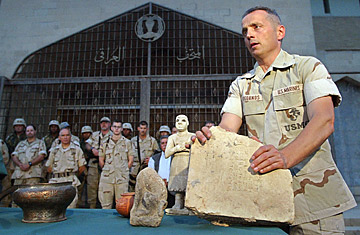
U.S. Colonel Matthew Bogdanos
(2 of 2)
Rather than chaos, however, news reports will often cite America's lack of post-war preparation for what happened after the invasion.
There is a lot of mythology about the looting of the Iraq museum. By and large that mythology has been debunked. And I've spent the better of more than 5, 6 years attempting to debunk it. But we should be clear on something: the looting could not have been avoided. It couldn't. It could have been and should have been lessened. But we should also be clear that the vast majority of the items that were removed were removed long before the war. So the war itself is not the reason the sine qua non of the looting. The looting took place from 1980 on.
It's important that people understand that. I'm not minimizing what was done during the war. I've spent the better part of my life over the last 5-6 years attempting to return to Iraqis their priceless cultural heritage. But what we should do is strip away the myths about the looting of the Iraq museum: that U.S. forces stood idly by while the patrimony of an entire country was looted. That didn't happen. Things did happen for which the world should be outraged. But not that.
There was an erroneous and exaggerated figure in the early days that 170,000 items that were looted. Does that number still come up?
Yes.The initial reporting claimed that 170,000 priceless artifacts were stolen in only 48 hours. Putting aside questions of Newtonian space and time and the impossibility of random looters getting 170,000 in 48 hours, that was truly exaggerated by at least a factor of 10. With some rare exceptions, the media has been very good about reporting the actual number stolen during the April time period, which is approximately 14,000 pieces. That's a tragedy in and of itself. One piece is one too many. (See pictures of disputed antiquities.)
How many items have since been returned?
As recently as January 2009, of approximately 14,000 that had been stolen, slightly more than 8,000 have been recovered or are in various stages of being returned to the Iraqi government. In December of 2008, three Iraqi antiquities were recovered in Peru. They haven't been returned to the government yet, but they have been recovered. That fact that they were discovered in Peru highlights a disturbing new development. Recovery was much easier when the markets were limited to New York, London, Paris and Tokyo. Which is what they've been for the last several decades.
But what we're seeing now in the last couple of years [are new markets in] Dubai, Bahrain, Lebanon, Peru. This is a challenge for the international law enforcement community. We had a comfort zone when we knew it was going to New York, London, Paris and Tokyo. But now that those markets have expanded, it's a problem for us.
Are there really people out there — aside from characters in James Bond movies — who like to have illicit pieces of art in their homes?
Yet another dirty little secret of the trade: there are people in the world who are prepared to spend tens upon tens of millions of dollars to own a piece of alabaster they can never publicly acknowledge or show anyone but their closest friends. That's a fact. Ultimately what it comes down to is pure, unadulterated lust.
You write that "antiquities trafficking has never been a victimless crime. It certainly is not now when it funds the roadside bombs that kill our troops." How much of this trade from your estimation is being funneled into things that are killing troops?
An ugly truth is that antiquities trafficking in Iraq is funding the insurgency and has since at least 2004. That's a fact. And it shouldn't surprise anyone. Mao tells us that terrorist organizations have to adapt in order to survive. Adapt or die. Look at the Taliban in Afghanistan. They're using opium to support their activities. Why? Because opium is a limitless cash crop. Well they don't have opium in Iraq. But what they have in almost limitless supply are antiquities. So they're using them to fund their activities. It is not the number one source of funding. Kidnappings for ransom and extortion will still always be the number one source, but it's on the list.
What will it take for you to stop using word failure, and what point will it take for you to use the word success?
International law enforcement and media spend a lot of time talking about all of the extraordinary pieces that have been returned, but I always want to come back to pieces that haven't been returned. My favorite piece is, in my view, the most historically significant piece that is still missing. That's the Lioness attacking a Nubian boy in 8th century B.C., made of Syrian ivory, overlaid with gold, inlaid with lapis lazuli and carnelian. It is still missing. It's always a painful reminder to me, and until each and every piece that has been stolen from the museum is returned, I will have considered my mission in Iraq to have been a failure. When the Iraqi people have everything returned to display in a museum open to all. That's how I define success.
